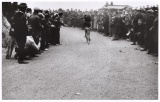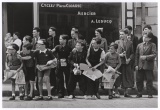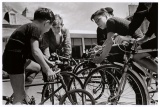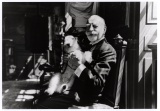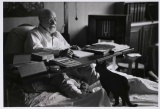Robert Capa
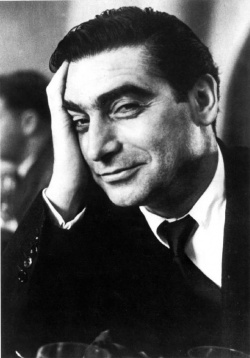 Robert Capaa (photo by Ruth Orkin, 1952). | |
| Born |
October 22, 1913 Budapest, Austria-Hungary |
|---|---|
| Died |
May 25, 1954 (aged 40) Thai Binh, State of Vietnam |
Robert Capa (real name: Endre Ernő Friedmann) was a Hungarian war photographer and photojournalist photographer, founder of Magnum Photos agency, with Henri Cartier-Bresson, David Seymour, William Vandivert and George Rodger. He documented the Spanish Civil War, the Second Sino-Japanese War, World War II across Europe, the 1948 Arab-Israeli War, and the First Indochina War.
Contents
Biography
On 3 December 1938 Picture Post introduced 'The Greatest War Photographer in the World: Robert Capa' with a spread of 26 photographs taken during the Spanish Civil War.
But the 'greatest war photographer' hated war. Born Andre Friedmann to Jewish parents in Budapest in 1913, he studied political science at the Deutsche Hochschule für Politik in Berlin. Driven out of the country by the threat of a Nazi regime, he settled in Paris in 1933.
He was represented by Alliance Photo and met the journalist and photographer Gerda Taro. Together, they invented the 'famous' American photographer Robert Capa and began to sell his prints under that name. He met Pablo Picasso and Ernest Hemingway, and formed friendships with fellow photographers David 'Chim' Seymour and Henri Cartier-Bresson.
From 1936 onwards, Capa's coverage of the Spanish Civil War appeared regularly. His picture of a Loyalist soldier who had just been fatally wounded earned him his international reputation and became a powerful symbol of war.
After his companion, Gerda Taro, was killed in Spain, Capa travelled to China in 1938 and emigrated to New York a year later. As a correspondent in Europe, he photographed the Second World War, covering the landing of American troops on Omaha beach on D-Day, the liberation of Paris and the Battle of the Bulge.
On 25 May 1954 he was photographing for Life in Thai-Binh, Indochina, when he stepped on a landmine and was killed. The French army awarded him the Croix de Guerre with Palm post-humously. The Robert Capa Gold Medal Award was established in 1955 to reward exceptional professional merit [1].
Robert Capa made photographs that achieved their exceptionally powerful effect through his strong connection to and affection for people. This attitude, and his use of the small 35-millimeter camera, allowed him to approach his subjects and throw himself into the action as no one else. The result was a breakthrough in the history of photojournalism [2].
Gallery
Eiffel Tower, Paris, July 1952
Henri Matisse in bed working, his black cat at his feet, (Cimiez) Nice, France, August 1949
Literature
- Death in the Making, 1938
- The Battle of Waterloo Road, 1941
- Invasion!, 1944
- Slightly Out of Focus, Henry Holt and Co., New York, 1947
- A Russian Journal, by John Steinbeck and Robert Capa, Viking, New York, 1948
- Report on Israel, by Irwin Shaw and Robert Capa, Simon & Schuster, New York, 1950
- Robert Capa: Photographs, Aperture Foundation Inc., 1996
- Robert Capa: Photographs, trans. Beatriz Karam Guimares, Cosac & Naify Edicoes, Sao Paulo, 2000
- Heart of Spain, 1999
- Robert Capa: The Definitive Collection, Phaidon Press Ltd, UK, 2001
- Blood and Champagne: The Life and Times of Robert Capa, 2002
- Robert Capa Connu et Inconnu, BNF éditions, Paris, 2004
Awards
- War Cross with Palm from the French Army (posthumously), 1954
